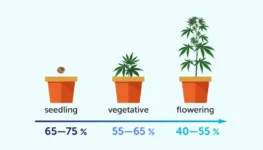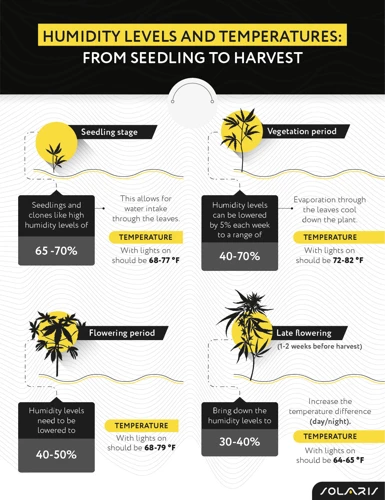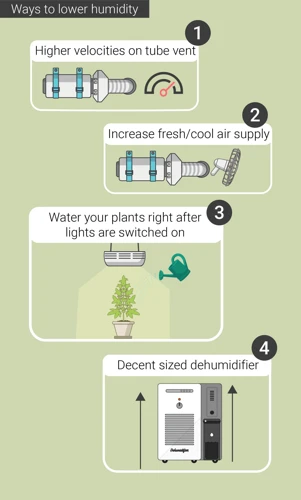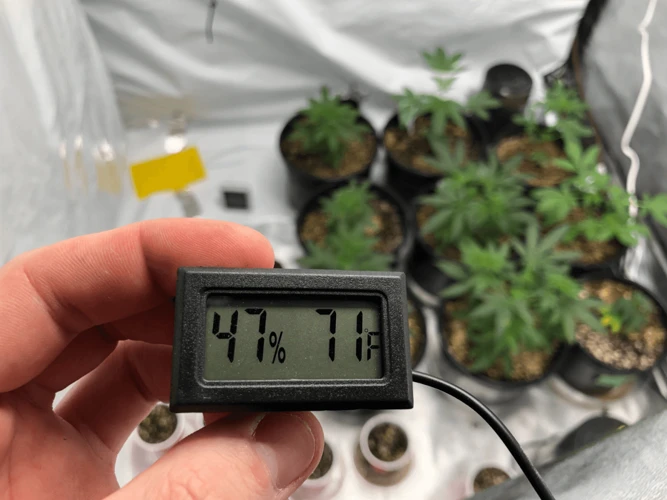
Why Monitoring Relative Humidity Levels is Important in Cannabis Growing
Growing cannabis can be a complex and challenging process, especially for those who are new to the endeavor. While many factors can impact the growth and quality of cannabis plants, one crucial aspect that often goes overlooked is controlling the relative humidity levels. The perplexing question is, what is relative humidity, and why is it so important in cannabis growing? In this article, we will explore the answer to these dilemmas and the significance of monitoring relative humidity levels while cultivating cannabis. We will also delve into the optimal humidity levels, methods of monitoring and adjusting humidity, factors that affect relative humidity levels, and techniques for preventing mold and mildew. Whether you’re a professional grower or an aspiring cultivator, this article will provide you with valuable information to maximize your cannabis yields and quality. Let’s get started!
What is Relative Humidity?
Contents
Have you ever noticed the moisture in the air on a hot and humid day? That moisture, or water vapor, is the key component of relative humidity. Relative humidity measures the amount of water vapor in the air compared to the maximum amount that air could hold at that temperature. This concept is crucial for cannabis growers, as controlling the relative humidity levels is essential for a successful harvest. Let’s delve deeper into what relative humidity is and why it matters in growing cannabis.
How is Relative Humidity Measured?
Relative humidity, often abbreviated as RH, measures the amount of moisture present in the air compared to the amount the air can hold at a specific temperature.
Relative humidity can be measured using several methods, including:
| Method | Description |
|---|---|
| Psychrometer | A psychrometer is a device consisting of two thermometers, one of which is covered by a wet wick. The difference in temperature between the wet and dry thermometers is used to calculate the relative humidity. |
| Hygrometer | A hygrometer is an electronic device that measures relative humidity. It works by using a sensor that changes resistance based on the amount of moisture in the air. This change in resistance is then converted into a percentage of relative humidity. |
| Dew Point Calculator | A dew point calculator is a device that measures the temperature at which water vapor in the air will condense into liquid form. By knowing the ambient temperature and dew point, the relative humidity can be calculated. |
It is important to regularly measure relative humidity levels in a cannabis grow room to ensure optimal growing conditions and prevent mold and mildew growth.
The Importance of Monitoring Relative Humidity Levels in Cannabis Growing
Maintaining the proper environment for cannabis plants is crucial for healthy growth and maximum yield. Among the many factors that must be controlled are temperature, lighting, and nutrients. However, one often overlooked factor that can significantly impact the quality and quantity of the cannabis harvest is relative humidity. This is why monitoring and adjusting humidity levels is essential. In this section, we will delve into the importance of tracking relative humidity while growing cannabis and explore the different facets of this essential task.
Optimal Relative Humidity Levels for Cannabis Growing
In order to grow healthy and high-quality cannabis plants, it is important to maintain the correct humidity levels. The optimal relative humidity level for cannabis plants varies depending on their growth stage, with different levels required during the vegetative and flowering stages.
During the vegetative stage, cannabis plants prefer a higher humidity level, ranging from 40% to 70%. This higher humidity level promotes healthy growth and development of the plant’s leaves and stems, as well as aids in the prevention of nutrient deficiencies.
However, during the flowering stage, the optimal relative humidity level decreases to 40% to 50%. Lower humidity levels help prevent mold and mildew growth on the plant’s flowers during this crucial stage, which can negatively impact the plant’s quality and yield.
It is important to note that consistently high humidity levels can also lead to a decrease in terpene production and an increase in pest and disease susceptibility. Monitoring and adjusting humidity levels is critical to producing healthy and potent cannabis plants.
Consistent Humidity Levels for Uniform Growth
Maintaining consistent humidity levels is essential for achieving uniform growth in cannabis plants. Fluctuations in humidity can lead to stunted growth, wilting, and even death of the plants. Consistent humidity levels are especially important during the vegetative and flowering stages of cannabis growth.
Here is a table outlining the ideal humidity levels for cannabis plants during their different stages of growth:
| Growth Stage | Ideal Relative Humidity Levels |
|---|---|
| Seedling | 65-70% |
| Vegitative Stage | 40-70% |
| Flowering Stage | 40-50% |
As you can see, the ideal humidity levels vary depending on the stage of growth. During the seedling stage, higher humidity levels are necessary to promote the growth of roots and foliage. As the plant matures, humidity levels can be gradually reduced to prevent the growth of mold and mildew and to encourage the development of healthy buds during the flowering stage.
Consistent humidity levels also help to promote consistent nutrient uptake and water absorption in the plants. When humidity levels fluctuate, the roots may become stressed and unable to effectively absorb nutrients and water, leading to poor growth and stunted development.
In addition to affecting the growth and development of the plants, inconsistent humidity levels can also have a negative impact on the potency and quality of the final product. Fluctuations in humidity levels can cause the buds to become dry and brittle or moist and moldy, resulting in a lower quality and less potent product.
It is crucial to maintain consistent humidity levels throughout the entire growing process to ensure the plants are healthy and robust, and to yield a high-quality cannabis product.
Preventing Mold and Mildew
Mold and mildew are common problems that cannabis growers face due to high humidity levels. These fungi thrive in damp conditions, and can easily damage the plants as well as the quality of the yield. It is essential to prevent mold and mildew growth to ensure healthy and robust plants.
The following are some of the ways to prevent mold and mildew growth in cannabis plants:
- Ensure proper ventilation – One of the main reasons for high humidity levels is poor air circulation. Adequate ventilation can help maintain ideal humidity levels and prevent mold and mildew growth. Use fans to circulate the air and maintain a consistent temperature throughout the grow space.
- Use dehumidifiers – It is essential to maintain relative humidity levels in the right range. One good way to do so is by using dehumidifiers. They help remove excess moisture from the air and maintain the optimal range for cannabis growth.
- Cleanliness – Keeping the grow space clean is crucial in preventing mold and mildew from flourishing. Any debris or organic matter in the grow space can attract fungi and cause growth. Maintaining hygiene by keeping the grow space free from dirt, dust, and plant debris can go a long way in preventing mold and mildew growth.
- Humidity-resistant strains – Some cannabis strains are more resistant to high humidity levels and can withstand damp conditions much better than others. Research and choose strains that are more suitable for growing in high humidity environments.
- Monitor humidity levels regularly – Consistent monitoring of humidity levels is essential to detect any deviation from optimal ranges. Use a hygrometer to measure the humidity levels and make necessary adjustments according to the readings.
Preventing mold and mildew from growing in cannabis plants is essential to ensure a healthy and high-quality yield. Adequate ventilation, the use of dehumidifiers, maintaining cleanliness, choosing suitable strains, and regular monitoring can help prevent mold and mildew growth.
How to Monitor and Adjust Humidity Levels in Cannabis Growing
Maintaining the proper humidity levels is crucial for successful cannabis growing. In this section, we will discuss the methods of monitoring and adjusting relative humidity in your grow room. Whether you are a novice or experienced grower, knowing how to control moisture levels is essential to ensure healthy plant growth, prevent mold and mildew, and ultimately yield high-quality buds. By utilizing the right tools and techniques, you can effectively manage humidity levels and provide the ideal environment for your cannabis plants to flourish.
Using a Hygrometer to Measure Humidity
To accurately monitor the relative humidity levels in your cannabis growing environment, you need a reliable tool called a hygrometer. A hygrometer measures the amount of moisture in the air and gives a reading of the relative humidity percentage. There are two types of hygrometers used for monitoring humidity levels in cannabis growing:
| Mechanical hygrometers: | Mechanical hygrometers use a hair or coil that expands or contracts depending on the moisture level in the air. This expansion or contraction is then measured by a spring or dial, which displays the relative humidity percentage. |
| Electronic hygrometers: | Electronic hygrometers use sensors to measure the amount of moisture in the air and provide a digital display of the relative humidity percentage. |
Both types of hygrometers are accurate and reliable, but electronic hygrometers are generally more popular due to their ease of use and reading accuracy.
When using a hygrometer to measure humidity levels in your cannabis grow room, it’s important to place the hygrometer in a representative location. Avoid placing it directly above or next to a humidifier or dehumidifier, as this can give inaccurate readings. Instead, place the hygrometer at plant height and away from any direct airflow to get a more accurate reading of the humidity levels in your grow room.
By regularly monitoring humidity levels with a hygrometer, you can ensure your cannabis plants are growing in the optimal environment for healthy growth and prevent any potential moisture-related issues from occurring.
Humidity Control Methods
One of the best ways to ensure that your cannabis plants receive the appropriate level of humidity is by utilizing humidity control methods. Here are a few strategies that can help you maintain the appropriate humidity levels in your cannabis grow room:
- Ventilation Systems: Installing a high-quality ventilation system can help regulate humidity levels. This system can seamlessly work with an AC or heating unit to control temperature and prevent humidity levels from dropping too low or becoming too high. Additionally, ventilation systems can help with proper air circulation and prevent mold and mildew from forming.
- Dehumidifiers: If the humidity levels in the grow room are consistently high, investing in a dehumidifier is a great option. Dehumidifiers work by trapping excess moisture and releasing dry air back into the room, which helps reduce humidity levels. This is especially helpful during the flowering stage, as high humidity levels can lead to mold and mildew growth.
- Humidifiers: On the other hand, if the humidity levels are too low, a humidifier can be used to add moisture to the air. This is particularly helpful during the vegging stage when plants require a humid environment.
- Drip Irrigation: This is another method of controlling humidity levels. By installing a drip irrigation system, growers can regulate water delivery to their plants easily. This system delivers water to the roots, effectively reducing the moisture present in the room, which can help manage humidity levels.
- Pungent Herbs: Plants like peppermint, lavender, or basil can help regulate humidity levels, adding some extra moisture to the air or reducing humidity in the grow room. Consider adding these plants to your grow room, and you can enjoy their aroma while also assisting in the growth of your cannabis.
By using these methods, you can effectively adjust the humidity levels in your cannabis grow room and ensure healthy plant growth.
DIY Humidity Control Techniques
If you’re on a budget, there are some DIY techniques to help control humidity levels in cannabis growing. Here are some ideas:
| Technique | Description |
|---|---|
| Ventilation | Improve air circulation with fans and open vents to reduce moisture buildup. |
| Dehumidifying Bags | Place silica gel packs or other moisture-absorbing materials in the growing area to help reduce humidity levels. These products can be purchased online or in stores. |
| Charcoal | Activated charcoal is a natural dehumidifier. Place it in a container with holes and distribute it throughout the growing area. |
| Humidity Domes | Placing a humidity dome over seedlings and young plants can help regulate the moisture levels for optimal growth. |
| Humidity Trays | Humidity trays are shallow trays filled with rocks and water. Plants are placed on the rocks, and as the water evaporates, it helps increase humidity levels. This method can be used sparingly to increase humidity levels temporarily. |
These DIY humidity control techniques can be effective, but they require regular monitoring to ensure that they’re working properly. It’s also important to note that these methods may not be as precise as using a dedicated dehumidifier or humidifier. Ultimately, investing in proper equipment will provide better and more consistent results for successful cannabis growing.
Factors that Affect Relative Humidity Levels in Cannabis Growing
Maintaining proper relative humidity levels is a crucial aspect of successful cannabis growing. However, there are a variety of factors that can impact these levels, and understanding how they interact can be perplexing. Temperature, air circulation, and plant transpiration are just a few of the considerations that need to be taken into account in order to achieve optimal humidity levels for cannabis growth. By gaining a better understanding of these factors, growers can ensure that their plants are receiving the best possible environment for healthy development.
Temperature
The temperature plays a crucial role in regulating relative humidity levels in cannabis growing. High temperature increases the moisture holding capacity of the air, which means that the air can hold more water vapor. This results in lower relative humidity levels. On the other hand, low temperature decreases the air’s moisture holding capacity, leading to higher relative humidity levels.
It is important to maintain a consistent temperature range in the growing environment to ensure that the relative humidity levels are also consistent. Fluctuations in temperature can result in fluctuations in relative humidity, which can be detrimental to plant growth and development.
High temperatures present a risk for plant dehydration, which can cause stunted growth, wilting, and other problems. When temperatures are too high, the plant will transpire more, resulting in lower relative humidity levels. This can also lead to nutrient deficiencies since the roots are unable to uptake nutrients under dry conditions.
Likewise, low temperatures can slow down plant growth and development, which can be problematic during the flowering stage. When temperatures are too low, the plant will transpire less, leading to high relative humidity levels. This can create an ideal environment for mold and mildew growth, which can ruin an entire crop.
To maintain a consistent temperature range, it is recommended to use a thermometer and adjust the temperature using air conditioning or heating systems. By keeping the temperature in the optimal range, growers can ensure that the relative humidity levels are also within the optimal range, promoting healthy plant growth and development.
| High Temperature | Low Temperature |
|---|---|
| Increases moisture holding capacity of air | Decreases moisture holding capacity of air |
| Results in lower relative humidity levels | Results in higher relative humidity levels |
| Risk of plant dehydration | Slows down plant growth and development |
| Can cause nutrient deficiencies | Creates an environment for mold and mildew growth |
Air Circulation
Proper air circulation is an important factor to consider when monitoring relative humidity levels in cannabis growing, as it can greatly impact the overall growing environment. When there is poor air circulation, the stagnant air can become humid, leading to potential mold and mildew growth. Additionally, the lack of fresh air can cause a buildup of carbon dioxide, which can stunt plant growth. On the other hand, too much air circulation can cause the humidity levels to drop too low, leading to issues with moisture stress for the plants.
One way to ensure proper air circulation is by using fans. Strong air flow can help to prevent stagnant air pockets and aid in regulating temperature and humidity. When using fans in your grow room, it is important to position them strategically to ensure that air is moving throughout the whole space. Make sure to avoid directly blowing air onto the plants, as this can cause physical damage.
Another tactic to improve air circulation is by creating vents or ducts to remove stale air and bring in fresh air. This is particularly important in grow rooms that are sealed off from the outside, as fresh air exchange can be limited. By creating vents or ducts, you can improve air flow and maintain optimal humidity levels. However, make sure to properly filter any air that is being brought into the room to avoid introducing pests or contaminants.
Table:
| Factors that affect air circulation: | Effects on relative humidity levels: |
|---|---|
| Stagnant air | Can lead to high humidity and potential mold and mildew growth |
| Insufficient fresh air | Can cause a buildup of carbon dioxide and stunt plant growth |
| Excessive air flow | Can cause humidity levels to drop too low, leading to moisture stress for the plants |
Plant Transpiration
As plants grow, they take in water from the soil through their roots and release it into the air through a process called transpiration. This is a natural and important process for their growth and survival. However, when it comes to cannabis growing, transpiration can greatly affect the relative humidity levels in the grow room.
Affected humidity levels: This is because as plants transpire, they release moisture into the air. If the plants are in a confined space, the moisture can build up and increase the overall humidity levels. On the other hand, if the plants are in a large open space with good air circulation, the moisture will dissipate more easily and not significantly affect the humidity levels.
Control over transpiration: Cannabis growers need to have control over transpiration, as it can greatly affect the overall humidity in the grow room. They need to ensure that their plants are receiving water at the appropriate levels and frequency, as over or under watering can affect the rate of transpiration, and therefore the humidity levels. The use of fans or air circulation devices can also help to encourage moisture to dissipate and prevent it from building up in the grow room.
Plant growth: The rate of transpiration is also affected by the growth stage of the plant. As the plant grows, it will transpire more and release more moisture into the air. Cannabis growers need to take this into consideration and adjust their humidity control methods accordingly.
Benefits of monitoring plant transpiration: By monitoring the rate of transpiration in the plants, cannabis growers can better control the humidity levels in the grow room. This can lead to more consistent and uniform growth, as well as prevent the growth of mold and mildew.
Conclusion
In conclusion, monitoring and controlling relative humidity levels is crucial for successful cannabis growing. Proper humidity levels not only promote uniform growth and prevent mold and mildew, but they also contribute to the overall health and quality of the plants.
To achieve optimal humidity levels, growers must regularly measure and adjust their growing environment using a hygrometer and humidity control methods. There are also DIY techniques that can be used to help maintain the desired levels.
It’s important to take into consideration various factors that affect relative humidity levels, such as temperature, air circulation, and plant transpiration. These factors can be managed by controlling the growing environment and providing adequate ventilation and air movement.
Overall, keeping a close eye on relative humidity levels can make a significant impact on the success of your cannabis plants. By implementing proper monitoring and control techniques, growers can ensure healthy and thriving crops.
Frequently Asked Questions
What happens if the relative humidity in the grow room is too high?
If the relative humidity in the grow room is too high, it can lead to mold and mildew growth, which can ruin your entire crop.
What happens if the relative humidity in the grow room is too low?
If the relative humidity in the grow room is too low, it can cause the leaves of your cannabis plants to turn brown and brittle, and your buds will not develop properly.
What is the optimal relative humidity level for cannabis growing?
The optimal relative humidity level for cannabis growing is between 50% and 60% during the vegetation stage and between 45% and 55% during the flowering stage.
Is it necessary to monitor relative humidity levels in cannabis growing?
Yes, it is crucial to monitor relative humidity levels in cannabis growing to prevent mold and mildew growth, ensure uniform growth, and produce a high-quality crop.
Why is it important to have consistent humidity levels while growing cannabis?
Consistent humidity levels are important in cannabis growing because they ensure uniform growth, which results in a higher yield and a more potent crop.
What is a hygrometer, and how is it used to measure humidity?
A hygrometer is a device that measures the relative humidity in the air. It is used by placing it in the grow room and monitoring the readings on the display.
What are some methods for controlling humidity levels in a grow room?
Some methods for controlling humidity levels in a grow room include using a dehumidifier, using an air conditioner, and installing an exhaust fan.
What are some DIY humidity control techniques that can be used in a grow room?
DIY humidity control techniques in a grow room include placing bowls of rice or salt around the room to absorb moisture, using a sponge to soak up excess moisture, and placing a tray of wet rocks near the plants to increase humidity.
Why does temperature affect relative humidity levels in a grow room?
Temperature affects relative humidity levels in a grow room because warmer air can hold more moisture than cooler air. This means that as the temperature rises, the relative humidity decreases, and vice versa.
How can air circulation affect relative humidity levels in a grow room?
Proper air circulation can help regulate relative humidity levels in a grow room by distributing moisture evenly throughout the space and preventing stagnant air, which can lead to mold and mildew growth.





